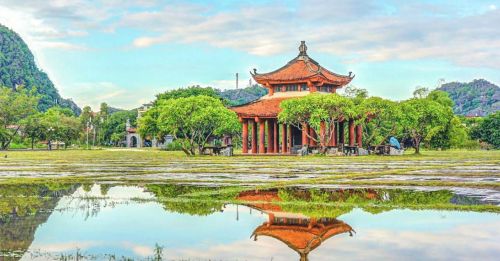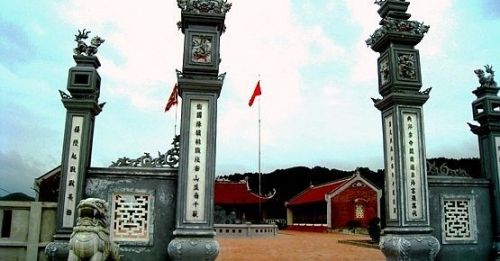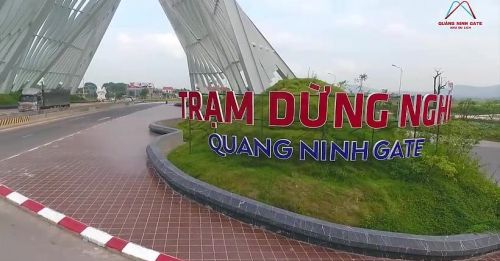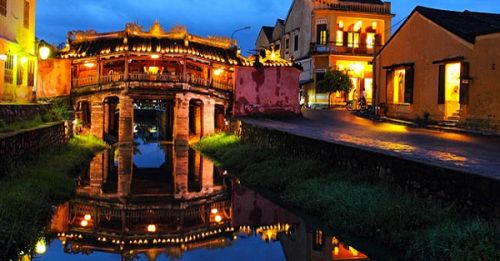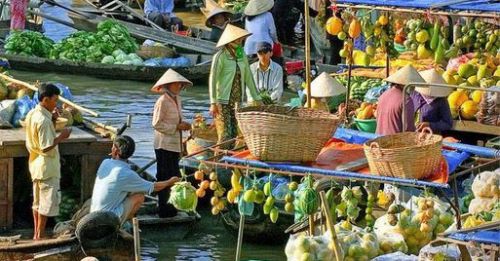Chinh Nguyet, admires Yen Tu mountain
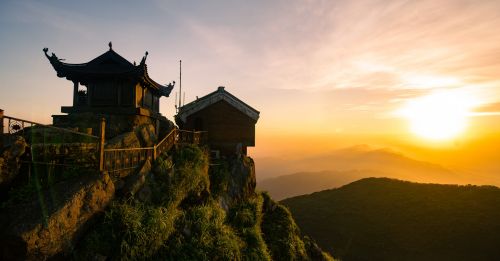
“Hundreds of years in the world of practice, Haven’t reached Yen Tu yet, haven’t achieved the results of practice”
The above two sentences are carved on a very large horizontal panel, hanging right in the middle of the traditional-style building of the cable car station at the foot of the mountain in Yen Tu. According to logic, “coming to Yen Tu” will be a necessary condition to become a “tutor”, but it seems that recently many people are misunderstanding that “coming to Yen Tu” is a necessary and sufficient condition to become a “tutor”. , so they try their best, as long as they reach the top, (perhaps) God and Buddha have already certified that they are true practitioners.
Recently, journalist Duc Hoang had a status on his Facebook page (and an online article) about the fact that Vietnamese people do not value gods, some temples are crowded, other temples are deserted; excerpt: “This ranking is not based on their merits, based on historical significance, based on the preciousness of the architecture and relics of places of worship, based on the lessons they left behind for posterity or anyone else. anything else humane. It is based on the so-called ‘sacredness’ or roughly the ability to bestow blessings – which is ranked by ignorant oral tradition. This 5-star place instantly became a sea of people spilling out onto the sidewalk, no matter who was on the altar or what they had done in history. That place is not rated, it is as lonely as any Nam Dinh pho restaurant.”
Quite a few people praised and cursed our people without hesitation. I’m not a Facebook friend so I can’t comment. Even though the article is basically correct, I still want to object a little.
In fact, people flock to temples and shrines based on the government’s recognition of sacredness. In previous dynasties, they conferred divine titles, with distinct upper, middle, and lower classes.
We don’t have time all year, the New Year holiday is only arranged for one day, so we have to join the crowd of people moving like waves into Yen Tu and accept the reputation of being superstitious, jostling to go to the temple like my brother. the newspaper said so.
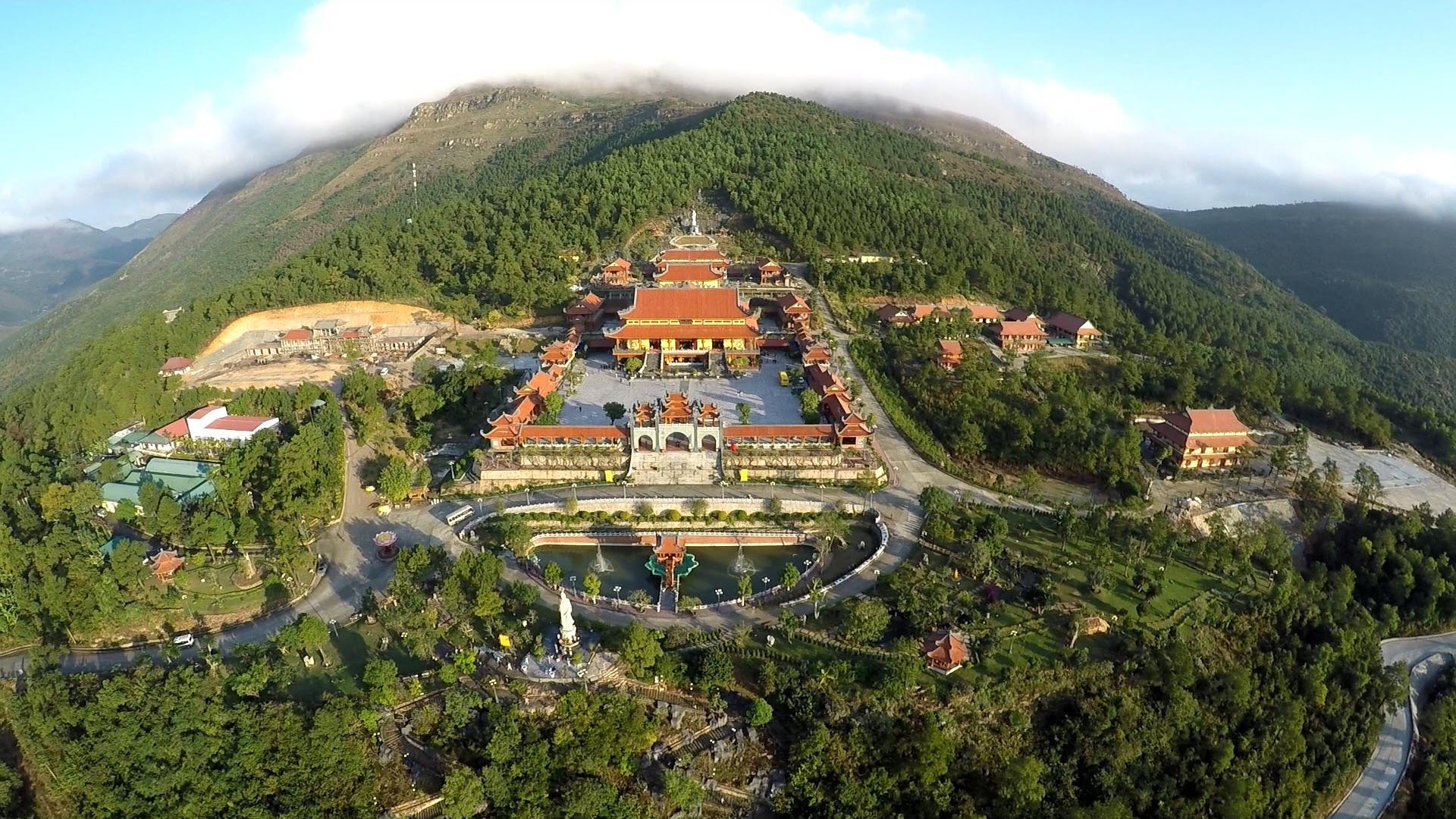
The view from above, looking down, is endless with mountains. All the pedestrians silently admired the scenery, only the sound of bamboo leaves rustling. The space in the middle is a parking lot and some sort of commercial service area project.
The most admirable thing is that Buddhists walk in a three-step, one-step worship style, kneeling once every three steps, and it takes several days to reach the top. A long time ago, when there was a cable car, my grandfather who was over 70 years old and his neighbor of the same age competed with each other by climbing Yen Tu peak. The two men climbed from the bottom of the yard to the top. When they got down to the middle, the neighbor couldn’t stand it. He begged to lose and got on the cable car to go back first. My grandfather continued to leisurely walk down to the foot of the mountain. The next morning, my grandfather went to the other man’s house to visit and found out that he had gone to… the hospital since the night. He came back and told his children and grandchildren: “Look at you guys, I can still walk, but you guys keep blaring on the cable car?” Children and adults sat quietly!
I listened to the advice of Mr. Candid, a cardiologist, so I started jogging to exercise. Seeing that my heart muscle is doing okay these days, I’m inspired to go for a walk again. People often climb Yen Tu to test their strength and it’s true to the slogan of Tung Lam company, the investor in the cable car system here:
“Journey back to yourself”.
The road is difficult not because it separates the river from the mountains, but because people are afraid of the mountains and the rivers .
Climbing, like running, is a form of challenge to overcome yourself. In the past, there were no steps, the road was still slippery, now there are steps, can you still climb? However, I was foaming at the mouth and had no one willing to climb with me, so I had to put my arms around my bag and set off alone.
The bus stopped off Street 18, in front of the gate of Trinh Pagoda .
According to the principle, you have to “go to Yen and return to Tu” (if you don’t want to “go to Yen and return to Tu”), but our people often “take shortcuts” so we have to skip the submission process.
I thought I’d have to take a motorbike taxi to get into the temple because it’s another 14km from the main road, but the road is small and crowded with cars so I can’t walk. Luckily there is a bus, 10,000 a ticket to go from the gate of Trinh pagoda all the way inside. This year I’m probably new to Ninh Binh, there’s still a distance left but the cars are blocked, visitors can walk or take the tram, take the car another 3km around to reach the foot of the mountain, it costs another 10,000.
For those who have never been to Yen Tu or have gone but don’t understand very well, I would like to briefly say this:
Like temple systems built on a mountain, Yen Tu also has three locations: Upper, Middle, Lower, but each pagoda has its own name.
Ha Pagoda is Giai Oan Pagoda, Trung Pagoda is Hoa Yen Pagoda (which most people read as Hoa Hien) and Thuong Pagoda towering on top is Dong Pagoda (literally called Thien Truc Tu but no one ever calls it).
In addition, there are many other pagodas, each pagoda has a Chinese name and a Nom name. The story, the purpose of building it, and who to worship is very complicated, so I recommend that those who are interested go online to learn more.
That day the sky was clear and cloudless. Standing at the foot of the mountain, you can see Dong Pagoda on the top, far away on the right is a cable car pole.
Anyone who goes to Yen Tu also wants to go to Dong Pagoda, but it depends on each individual’s health situation.
My itinerary this time is as follows: take the bus and tram from Trinh Pagoda (1) to the yard, climb a bit to reach Giai Oan Pagoda (2) .
Continue to Hoa Yen Pagoda (3) , rest, continue climbing to Van Tieu Pagoda (4) , rest, climb to An Ky Sinh – Buddha Emperor Statue (5) , rest, go up to Dong Pagoda (6) .
Getting here takes 2 and a half hours. Go down to An Ky Sinh cable car station (7) , take cable line 2 to Hoa Yen, walk to line 1 station and get down to the yard (8) .
This cable car ride takes 1 hour, mainly due to queuing. The technical term for this journey is “going up with your feet, going down with your butt”, not because I don’t have enough strength to climb down, but because time is tight, there’s another trip tomorrow, so I have to take the cable car to get there. short time.
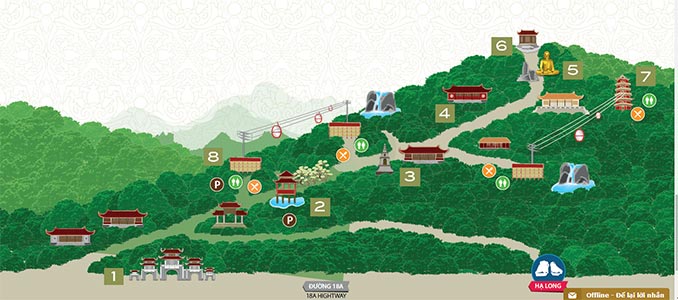
Map of the relic site on Tung Lam company’s website, I added numbers for ease of explanation. The drawing is very beautiful, very similar, except the gentle slope is deceptive.
That day was on the fourteenth day of the first month of the Year of the Monkey. The festival had just opened on the 10th, and it was on a Sunday, so I expected it to be very crowded, but I reassured myself that I was going alone so I wouldn’t have to wait for anyone. Let’s go first. Who would have thought there were as many people as ants, the line of people waiting for the cable car stretched all the way to the outside and the line of people hiking was equally crowded, in many places they had to walk while waiting for people above. When I got to Giai Oan Pagoda, I couldn’t squeeze in, so I had to skip it and go straight without stopping to Hoa Yen. Just walk and swing around because people often walk in rows of three, but walk slowly, many people innocently stand and rest… in the middle of the road. At times, I was so frustrated that I had to shout: “Whoever is going slow, please move to the right so the next person can go with you.” As Vietnamese people, it’s the opposite: the slower we go, the more we go to the left, so we have to “pass right” continuously.
I knew in advance that climbing the mountain would be hot, so even though it was a bit cold, I only wore one sports outfit – pajamas, gray clothes, and a thin windbreaker in my backpack. Passersby looked at me like I was a strange creature, then after a while there was a man sitting on the side of the road, sweating profusely, his jacket tied around his waist like so many people, nodding: “It would be appropriate to dress like this guy.” “, the wife immediately said: “Let’s go out, go to church, how can we wear it when it’s cold like that!” (She was wearing a red life jacket, the kind that had many wrinkles and was as wet as a rat).
From Giai Oan to Hoa Yen, there are two roads: Duong Truc or Duong Tung. I chose Tung street (as in the diagram, there are some trees drawn right behind the pagoda and Giai Oan stream).
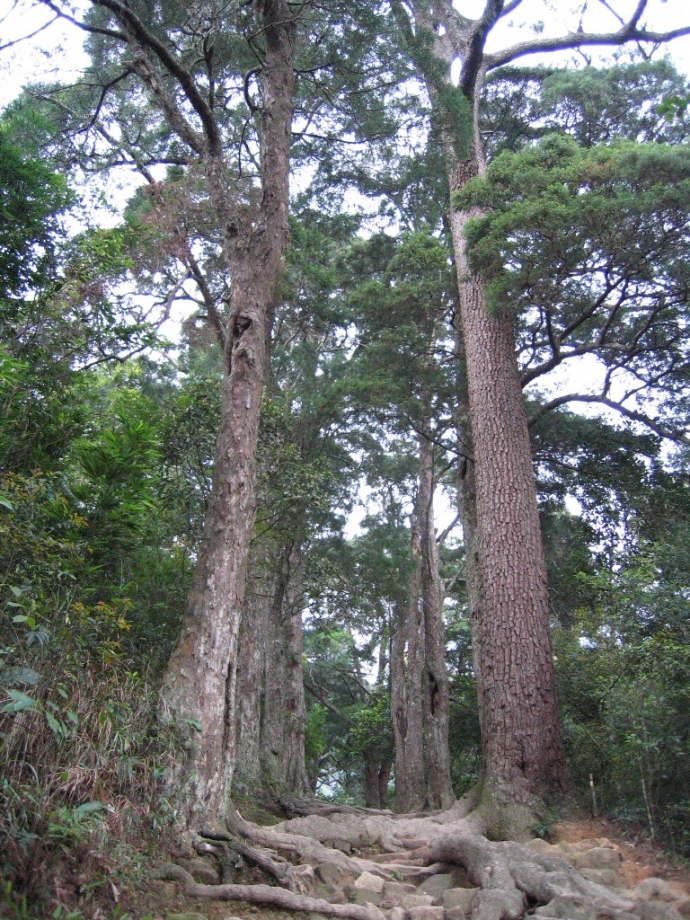
On both sides of the road are rows of tall, hundreds of years old pine trees. Even though it’s not Truc Street, bamboo still grows densely on the left side of the street. Pedestrians also hold many bamboo sticks.
The roots of the pine trees are very large, zigzagging on the ground and crossing back and forth on the road surface. At this point, the weak people began to feel listless and sat and rested a lot on both sides so the road became more open. Those who were still climbing were already tired, so they didn’t care about the tree roots, just stomped on them, holding on to any branches protruding from either side. I have loved plants since I was a child, so I was afraid of hurting Mr. Tung’s feet, so I tried to avoid them as much as possible. Looking at the roots of the Tung people, shiny like the heads of the Turtles, makes me sad. Through the Hue Quang tower garden with leafless giant trees (very beautiful photos without people) to reach the foot of Hoa Yen pagoda. It takes half an hour to get here, half an hour is a fairly quick climb, so when you get here you have to stand and rest and drink water.
This place is also the exit of Hoa Yen cable car station. Only foreigners coming from the cable car station are Koreans. They thought that when they got off the cable car, they would reach the temple, but they still had to climb, especially the steep slope right at the foot of Hoa Yen. Curly-haired women wearing visor hats cried out like “oh my god”, “oh my dad”. yeah”. Rest for exactly half an hour then hit the road again. It was impossible to enter the main hall of Hoa Yen Pagoda. I had just bowed three times when someone put his hand under my armpit, thinking he was pickpocketing, but it turned out they were putting money in the merit box. Well, I had no choice but to bow and pray, but I had to squeeze in forever to get out.
The section starts from Hoa Yen to Van Tieu. Occasionally, there were people who left early and came down from Dong Pagoda. They happily encouraged those who were climbing: “Come on guys, you’re halfway there, it won’t take many more hours to get there.”
From Hoa Yen Pagoda, there are two ways, one through Bao Sai Pagoda, the other through Van Tieu Pagoda. The road next to Bao Sai Pagoda is gentler but longer. “As many times as you benefit in terms of strength, you lose as many times in terms of travel”, I heard a guy standing there state the Law of Work to his son like that. I chose to go to Van Tieu, not because it is shorter but because it is steeper so there are fewer people going. It is said that it is sparse, but after going up a block, there is a traffic jam. The road on this side is much steeper, there are places where you can’t get up if you don’t hold on, luckily they built handrails. It was so steep that a guy happily said to his friend: “The other day, when I read the newspaper, I saw that fishing floats weren’t good for eating. During Tet, I just threw away all the fishing floats. Today I can freely eat to make up for it.”
Going up to Van Tieu Pagoda, the atmosphere is completely different. Van Tieu means Cloudy Sky. Less people is one thing, but the scenery is also different, there is more smog and the breath of mountains, rocks, trees, and sky all give us an extremely relieved feeling. The temple is quite deserted, you can knock the bell comfortably without being interrupted by anyone. Sit and breathe some clean air for about fifteen minutes and then continue.
Van Tieu Pagoda. Taking photos of ancient relics in Vietnam is very difficult, without people there are slogans, without slogans there are signs!
After a while, the two Bao Sai – Van Tieu roads merge into one, going up to An Ky Sinh. Previously, An Ky Sinh was just a landmark close to Dong Nhat Pagoda. There is a human-shaped stone here, the statue of which is said to be the Taoist An Ky Sinh, who was waiting for the elixir to cook for too long and transform into it. Now people have brought up a very large Buddha statue and built a cable car station from Hoa Yen. Previously, the cable car only went to Hoa Yen, so the section from Hoa Yen upwards was the more difficult climb, relatively airy, although holidays still had the quiet atmosphere of a place of worship. Now, after sitting on the cable car for a while, people flock together to go to the festival, the statue of An Ky Sinh is in the middle of the road, overlooked, people stand and take pictures happily “at the place of that huge, golden statue.” sir”. In the crowd, there were many people with Southern accents. I happened to meet a person from earlier in the yard who picked up a hat for me: “Oh, you’ve come all the way here, so you walk as fast as me taking the cable car, which also takes two hours, my family has to stand in line.” It’s been a long time”. Viettel built a wave tower here, causing young people to post photos on Facebook in a hurry. The time of tourism is here!
Again, the words of the person on the side of the road: “Wow, you people, they look just like Huong Pagoda, don’t they?”. Another opinion: “The crowd is just like the Yuan army!”. Answer: “Nguyen, Nguyen, it’s all Vietnamese people who defeated the Yuan army.” In conclusion: “Today we see that our country is truly ninety million people.”
The last section up to Dong Pagoda is full of jagged rocks, but people have also made small blocks of cement mixed with gravel to step on. Usually when people reach the top, the destination of a journey, they feel refreshed. In the case of Dong Pagoda, Yen Tu peak is just a tiny cliff, but there are many people (using the cable car) to go up, so there is an overload of standing space, as if the streets of Hong Kong are at rush hour. Unable to squeeze in and also unable to stand still, I had to go around the back of the temple to find a way down. Behind the temple, the ladies and gentlemen are trying to grind money into the base of the temple. The copper water shines like it’s about to celebrate Tet, when parents order the children to use salt and vinegar to polish the altarpiece. On a cliff were crowded with members of a certain martial arts sect wearing white martial arts uniforms, sitting everywhere, mainly children who were still in school, making the already crowded space even more crowded.
The road down from Dong Pagoda is very beautiful, the steps are straight and the slope is moderate. Immediately, I saw the two guys in front suggest: “If you know how to go up this way, you won’t have to climb the rocky road just now.” My mouth was so itchy that I had to speak up to suppress the idea of going in the opposite direction: “If you don’t climb like that, how can you prove it?”. After a short while of order, a voice replied: “But you can only get there as long as you can, the elders will witness.” And later, I saw a few people actually going in the opposite direction.
There are people everywhere. Well, I had to take a photo of Si Van on the roof of Dong Pagoda. I don’t understand why they designed a lovebird sitting on top of a knife?
Take the cable car and go down to see the steep slope of Van Tieu street. The mountain and forest scenery on both sides is very beautiful. Vast bamboo, ancient green pine trees towering, and in some places there are very beautiful and strange flowers. But honey, hide well, people have uprooted Yen Tu yellow apricot and planted it in clean pots, and now they’ve started digging Yen Tu bells again. The scene outside is beautiful and the scene inside the cabin is equally interesting. I sat with all the women, mothers, children, and grandchildren. Some closed their eyes, pursed their lips, some put their hands on their faces, some covered their ears and then all clung tightly to each other. When the cabin passed a column, it shook and felt a bit wobbly, a beautiful girl screamed: “Oh my god!”. The little girl was curious, opened her eyes and glanced at the forest trees, but her mother immediately shouted: “Close your eyes, don’t look, it’s very scary!”. It’s clear that I’m guilty, I’m so afraid of going, why go there to suffer? If something happens to me, I’ll regret it for the rest of my life. I was going to tease her and tell her that the ticket said she had insurance, but I was afraid of getting scolded so I stopped. Queuing to go down the cable car was quite difficult, but it was nothing compared to the kilometer-long line of people waiting to get up, which was lined up in rows of five or six, not two. I blurted out: “If you want to get out of the sea of suffering, if you can’t, then you’ll wait for each other to get in.” The whole group walking around us laughed like crazy, while the army waiting to go up on the other side looked bewildered and didn’t understand anything.
Sky-high price list (literally – 912m above sea level).
When I got down to An Ky Sinh, I was so hungry. I had bread to bring with me, but I still wanted to go in and eat something with water. I never eat instant noodles all year round because my cousin works in a noodle factory, so today I’m breaking the rule. Despite the skyrocketing inflation, the price of this bowl of noodles for ten years has not changed.
It’s also not clear how far the distance is to Dong Pagoda. I don’t have a modern distance measuring device. I saw someone saying it was 6km, so I knew that. So we walked, wandered, and ate and drank for five hours. At 3 o’clock in the afternoon, we were on the bus to the highway. It was hot and sunny. The bus was full of students’ buttocks facing our faces without feeling anything. It’s unclear whether it’s because the mind is calm or because the car’s air conditioning is weak. Sitting in a car for ten miles is more tiring than climbing ten miles up a mountain. During the past few years, Tet has been hot, and there has been no spring rain. I often complain, but my mother says: “Well, the sunshine will help motorcyclists feel less miserable. Even if they go somewhere far or go back to the countryside, it will be less cold.” That’s right, I went to the temple but never thought of it like that!
A friend wants me to take a photo to prove that I’m going to Yen Tu this year, but what kind of photo should I take to make sure I’m going this year and not using photos from previous years? I couldn’t help but take a photo of the newly built road sign. The design is also quite beautiful, proving that the tourism infrastructure here is complete.

